Microsoft Surface 2 Review
by Anand Lal Shimpi on October 21, 2013 12:00 AM ESTSoC, CPU & Performance
At the heart of Microsoft’s Surface 2 is a quad-core NVIDIA Tegra 4 SoC. That’s four usable ARM Cortex A15 cores running at up to 1.7GHz (1.9GHz with only a single core active), behind a shared 2MB L2 cache. You also get NVIDIA’s most powerful ultra mobile GPU to-date, a 72-core implementation of its ultra low power GeForce architecture. The combination of the two gives Microsoft a much better platform than the original Surface RT device.
The difference is immediately apparent. While Surface RT felt slow, Surface 2 feels fast enough for most light workloads. Typing in Word now typically consumes < 20% of all available cores/CPU cycles, compared to 20 – 40% on last year’s Tegra 3 based model. I can still get CPU utilization as high as 50% by pounding on as many keys as fast as possible, but that’s the exception not the rule.
If you remember back to my first Surface RT review I talked about how I could sometimes type quicker than the system would be able to process and display my text. I’m happy to say that’s no longer an issue, although I’m not sure how much of it is software vs. hardware improvements. Needless to say that for general Office work, Surface 2 is a much better device than its predecessor.
Application launch times are also a bit better compared to Surface RT at launch. Some apps still take longer to initialize than their equivalents under Android or iOS, but the improvements over the past year have been significant. Applications that used to take 5 – 7 seconds to launch now take 2 – 4 seconds. That’s compared to the < 2 seconds for most of the core apps on iOS, but it’s movement in the right direction at least.
On the CPU side we don’t have a ton of great performance tests to let us compare platforms (not yet at least), but we do have our standard suite of js benchmarks. Since we’re dealing with Windows RT, the only browser option is Internet Explorer 11 – which is both a blessing and a curse depending on what benchmark you’re looking at.
I’ll start with SunSpider since that appears to be the best case for IE11. Here we see just how much software can influence the overall performance of these browser based benchmarks.
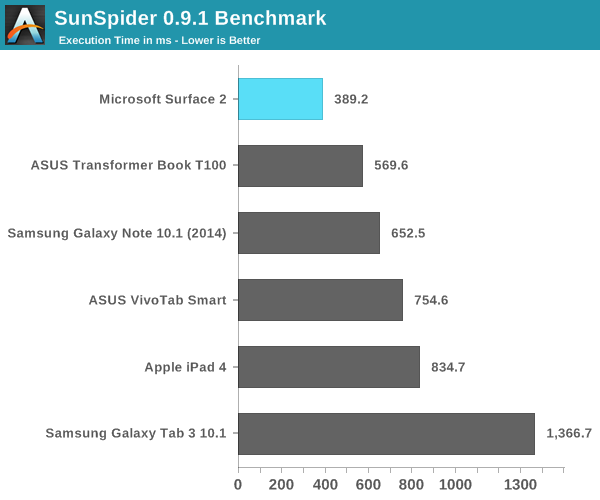
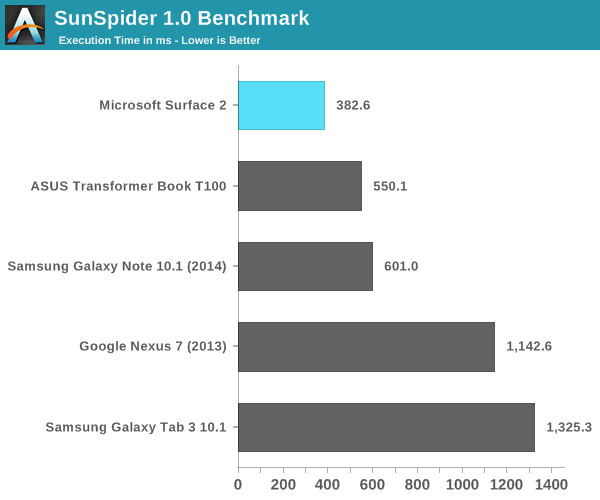
Tegra 4 running IE11 posts a better SunSpider score than even the A7 based iPhone 5s. Looking at the rest of the tests it’s very clear that SunSpider was an optimization target for Microsoft, as we don’t see this sort of performance leadership repeated anywhere else.
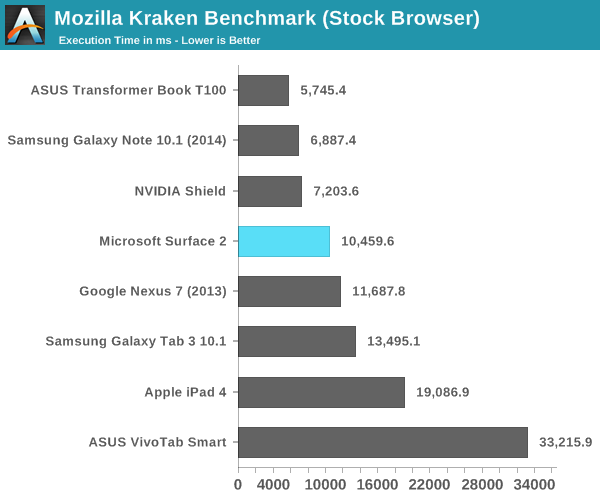
The Kraken results look decent but clearly behind high-end Android devices running Chrome. This is a huge improvement over where Microsoft was last year with Surface RT. Surface 2 can now complete the Kraken test in roughly 1/5 of the time it took Surface 1/RT to do the same work at launch. Obviously we’re seeing the benefits of IE11 in addition to Windows RT 8.1 being better optimized for ARM architectures (as well as a faster SoC), but the new tablet is just significantly faster than its predecessor.

Browsermark 2.0 gives us a good idea of where Surface 2 falls in terms of overall browsing performance. In general we’re dealing with a platform that is roughly comparable in performance to modern Android devices, but it’s not pushing the limits of performance in any way.
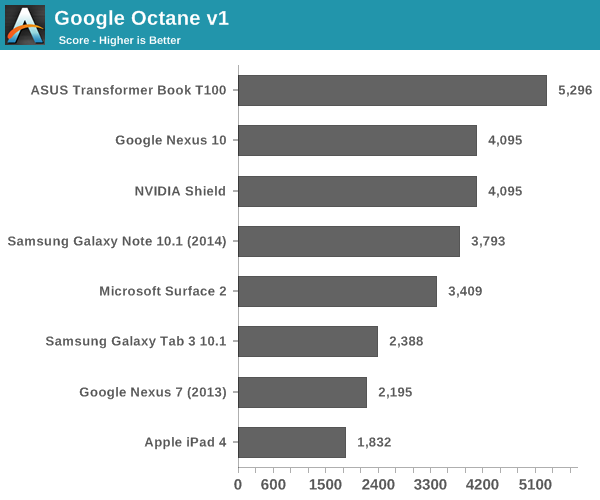
Google’s Octane test is obviously best optimized for Chrome, and here we see solid performance although clearly behind the fastest Android and Bay Trail devices.
GPU Performance
All of the Windows RT devices that launched last year had pretty terrible GPU performance. It didn’t matter if you had something with NVIDIA or Qualcomm inside, GPU performance wasn’t great at all. Even Intel’s competing Clover Trail solution was a huge let down on the GPU front. Clover Trail was so bad that I even noticed differences in animation frame rate between the Atom Z2560 and Qualcomm’s APQ8060A running Windows RT.
Tegra 4’s GPU on the other hand seems well suited for the task at hand. I doubt many users will be playing 3D games on Surface 2, but GPU performance is improved substantially over its predecessor. In the grand scheme of things we’re talking about roughly iPad 4 class GPU performance, all while driving a lower resolution screen.
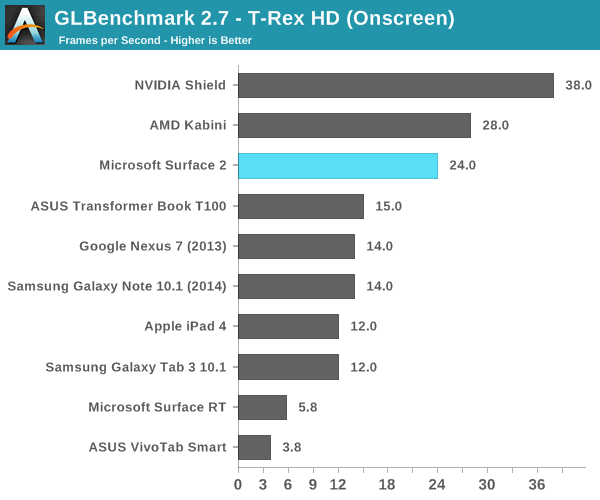
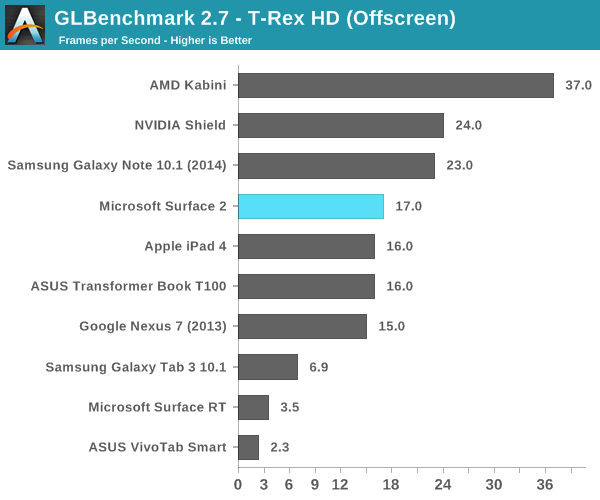
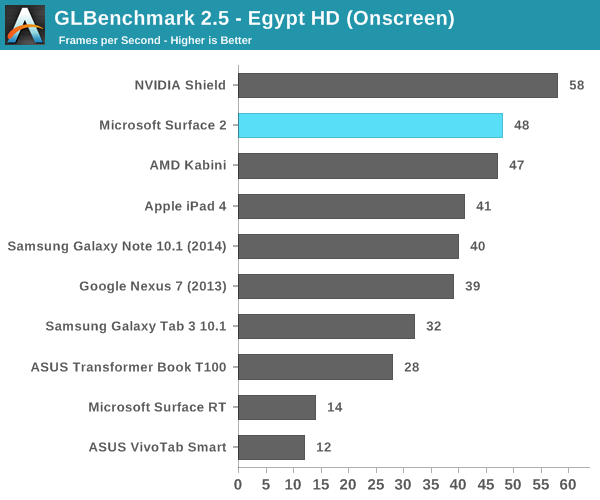
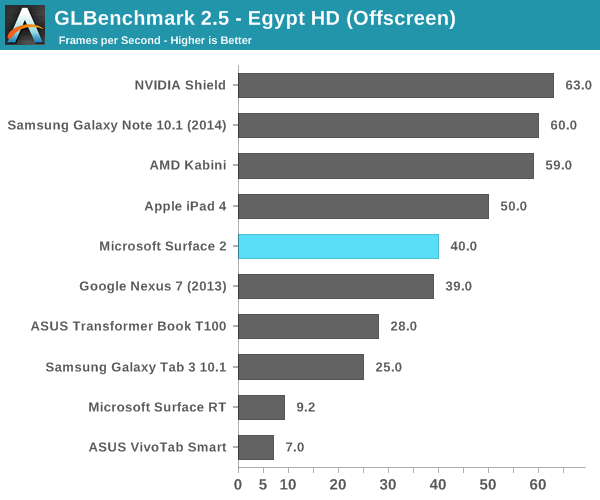
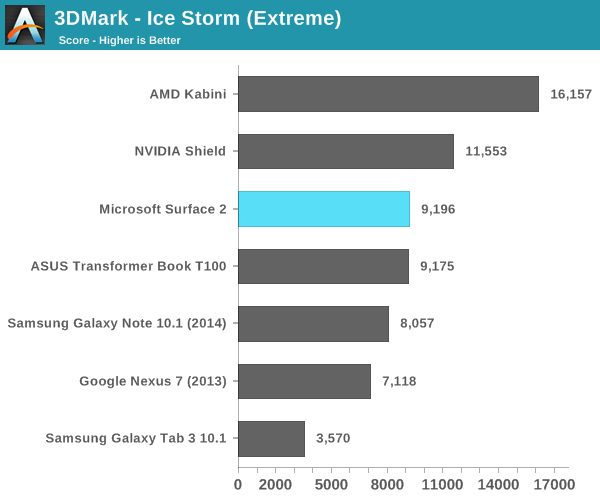


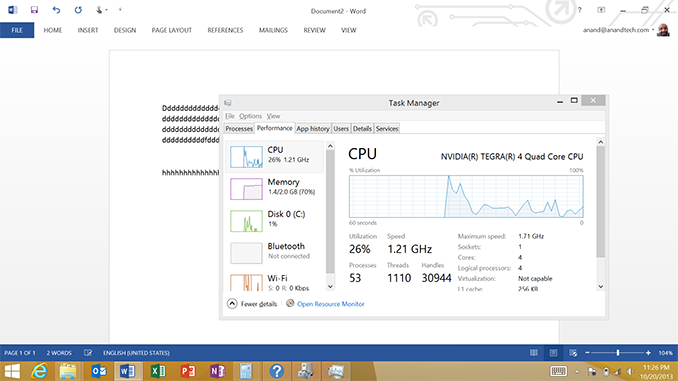








139 Comments
View All Comments
sri_tech - Monday, October 21, 2013 - link
What Google services you think are better than Microsoft services? I don't understand the fascination towards these chromebooks.1. Google docs are wannabe MS Office which does not have the most of the functionality and not compatible with many peripherals.
2. Outlook.com is very good email client and in addition Outlook for work related things.
Can't you access the gmail from browser? If you need app for everything what is the point of all the browser tests that you guys do in every review.
You can pin the gmail.com to the start screen and with just a tap, you will be in gmail. That is how everyone using them on laptops right?
3. Skydrive is very good and has all the features and more cross platform than Google drive.
4. Skype is integrated into the OS which is more widely used than any Google equivalent.
5. Can you use chromebooks as tablets? Does chromebooks have touchscreens?
6. All the bing apps like news, finance, travel, weather are not useful?
I expect better from you guys.
noeldillabough - Monday, October 21, 2013 - link
I have a huge problem with skydrive; although this might not apply to these tablets, but if you want to use it you must log in with your Microsoft account. If you're on a domain and login with your domain credentials and click on skydrive in 8.1, it prompts you to switch to a connected account.Unfortunately this renders Skydrive completely useless. I'd be fine if I could add my Microsoft account in and still log in with the domain account but you can't anymore. Maybe an oversight.
sri_tech - Monday, October 21, 2013 - link
A Microsoft service needs Microsoft account. So does all other services from all companies.I don't understand your second point.
noeldillabough - Monday, October 21, 2013 - link
The issue is in windows 8 you could enter your Microsoft account information for SkyDrive without having to switch your login account to a connected account. Now its forced and if you have a corporate device logging in with your Microsoft account won't be allowed.Wolfpup - Thursday, October 31, 2013 - link
Yep. Microsoft has ironically killed support for Skydrive on Windows 8.1.dustwalker13 - Friday, November 22, 2013 - link
yes it is a bit annoying that you can not change the account, since it has been integrated so deeply with the system now. but actually i do not mind all that much. what it means in the end is that my own devices are synced with my account, and should i need data from another account i can:1. share them and access them this way
2. login to the other account via the browser
so actually that is a nonexistant problem once you think about it and a logical solution for microsoft as they save all the important settings on skydrive for your devices and thererfor of course want you to be connected to your account at least on that level.
althaz - Monday, October 21, 2013 - link
His issue (mine as well) is that when you are at work, your domain account should automatically count as a Microsoft account. I don't want to login with my home MS account to do work stuff, that would a) jumble my shit together and b) not make sense. Currently I get around it by having a second microsoft account, but that's a super-long way away from ideal.damianrobertjones - Monday, October 21, 2013 - link
If you're on a domain it means business and the business should ALSO provide you with the Outlook.com account. At no point should you realistically be using YOUR OWN personal account on the business machine.cjb110 - Monday, October 21, 2013 - link
Yea, at most you should be able to share (given your security guys allows you) your business data with external untrusted accounts (which your personal one is).FredyHandanovic - Monday, October 21, 2013 - link
My Uncle Andrew just got a nearly new red Mazda MAZDA6 Sedan by work part-time using a lap-top. look at here now http://goo.gl/dXg26D